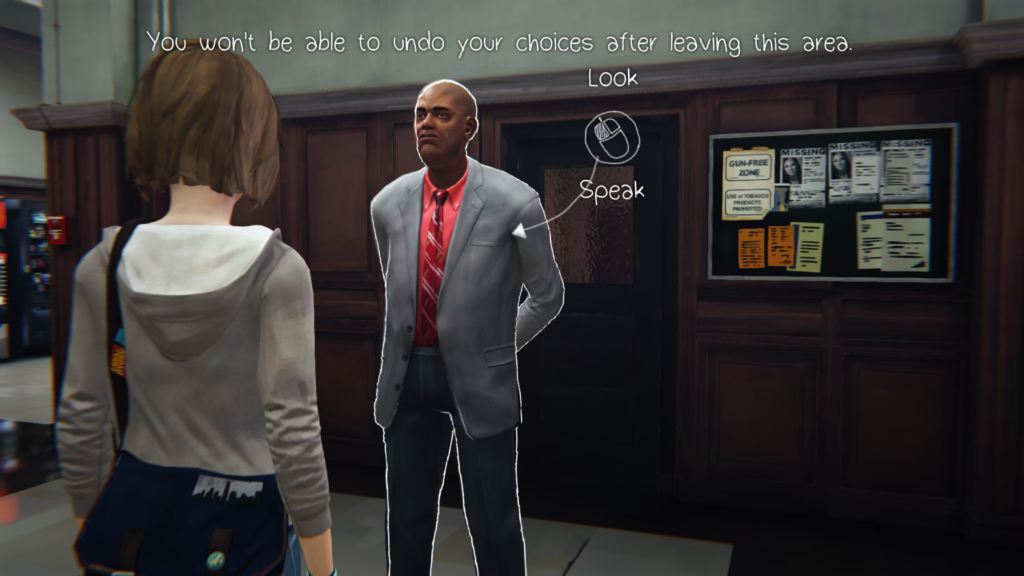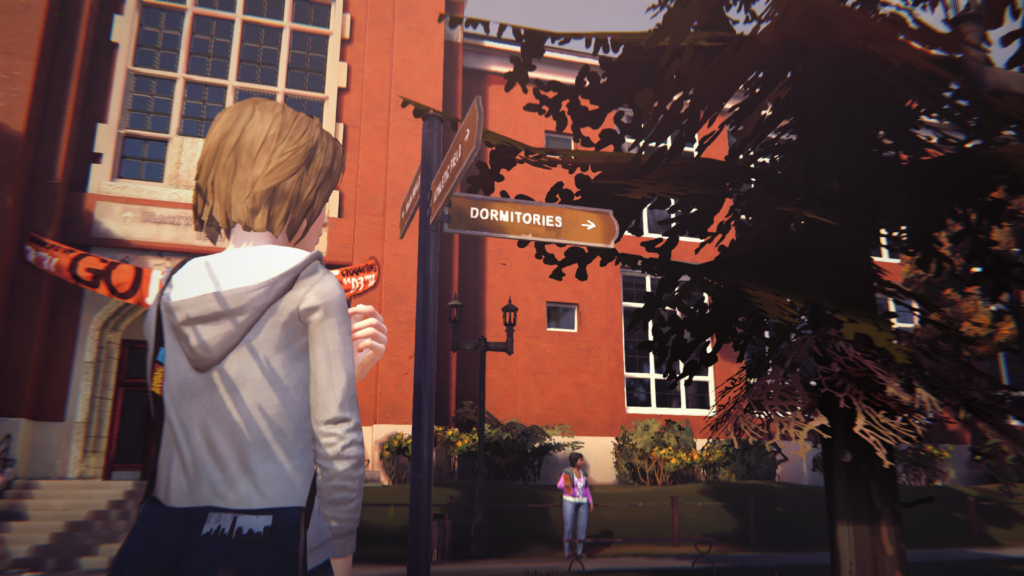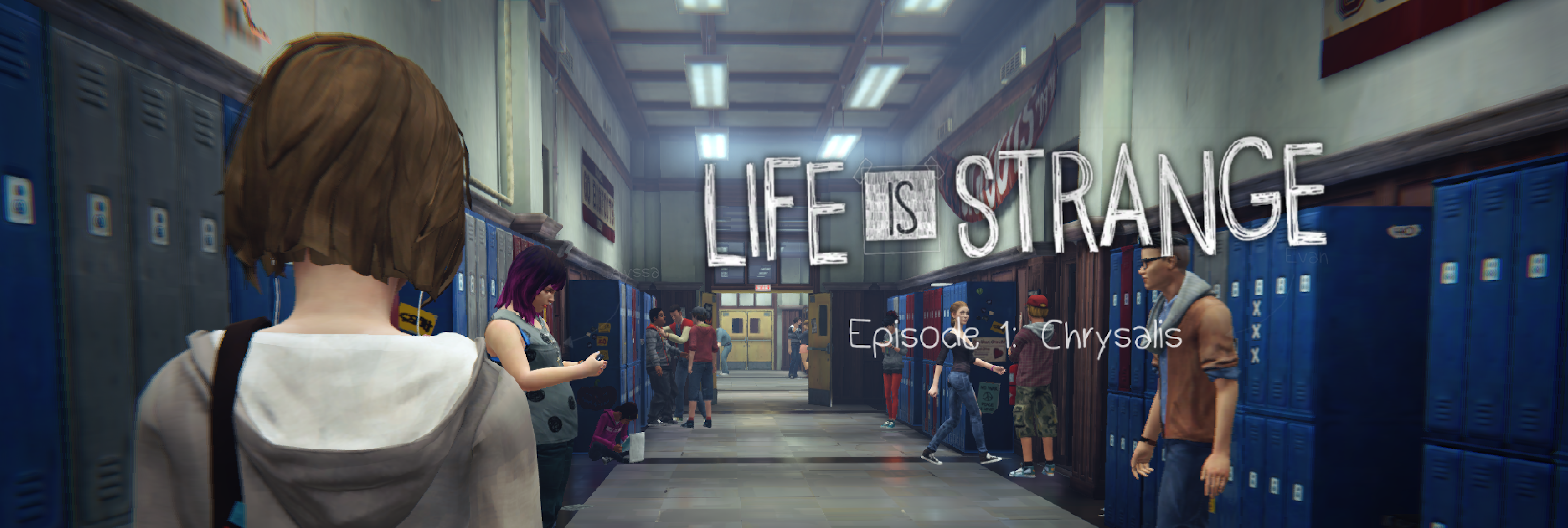About the game
This week I played the first episode of Life is Strange on my Mac via Steam. Life is Strange was developed by Dontnod Entertainment and published by Square Enix. The protagonist of the game is a high school photography student named Max, so the target audience for the game is likely young adults as well as anyone who enjoys a good mystery.
The player first encounters Max in a thunderstorm by a lighthouse. Once reaching the lighthouse, both the player and Max are transported to a photography class where Max discovers that she has the ability to rewind time at any moment.
Narrative & Mystery
The narrative, architecture of the game, and mechanics all come together to create an immersive experience that invites the player deep into the life of a self-conscious teenager making her way into settling into her new boarding school. The player directs Max to make certain choices. For example, after averting a crime from taking place at the school bathroom, the player has to decide whether to tell the truth or hide the truth from the high school principal. Each choice impacts the future for Max. With her time altering abilities, she is able to go back in time to make different choices. Often, she is unsure (as expressed through the emotional tones of her monologue) of the choices she makes, which incentivizes the player to try a different path.

Additionally, the player can examine and interact with objects, such as Max’s journal. The player can also approach and talk to other characters, open doors and drawers, and take a closer look at posters and other random objects around the school and dormitory. This interactivity incentivizes the player to explore the surroundings for clues and information.
Max does not know why she is able to go back in time, and neither does the player. In this way, narrative is woven into the mystery. Additionally, the narrative includes mini tasks that get Max and the player closer to solving the mystery. For example, we don’t know who Warren is but we know that we need to return a flash drive to him in order for the story to unfold. These mini tasks accumulate and progress the player towards gaining all the information they need to ultimately solve the larger mystery.
Mechanics & Mystery
The mechanics of the game support the mystery. Specifically, there are numerous interactive elements in the environment, and the player can not reasonably interact with them all. This creates an ideal environment for player choice. The player must choose what they want to interact with and take an educated guess on what objects may further the story. This introduces more mystery as the player might wonder what they might learn if they were to interact with other parts of the story. Additionally, one of the mechanics is to allow the player to inspect the space they walk through in all directions (in other words, the vantage point of the camera is flexible). This mechanic encourages the player to be observant and engaged in the details of the story. In order to make it into the dormitories, which is one of the mini challenges that propel the story forward, the player must find the signs that signal the direction of the destination (e.g. dormitory signposts). This is an example of how architecture propels stories forward.

Formal Element: Boundaries
In terms of formal elements, boundary plays a very important role in the game. The “magic circle” is intentionally vague. It is not immediately obvious what the boundaries of the game are since it starts outdoors in a storm and abruptly transports the player into a classroom. The school itself is not the boundary, as the story expands into the dormitory. The broad “magic circle” creates a realistic sense of place while still maintaining containment for each scene. For example, one of the mini tasks is to find an alternative entry to the dormitories, but you can’t venture too far without being nudged back to the action via a flashback to what has happened and a signal to rewind time. In this way, the architecture of the world Max lives in supports the narrative by providing enough context to further the story and imply a large sense of space, while still containing the gameplay and focusing the player on specific tasks.
Types of Fun
This game is a mix of narrative and fantasy, with aspects of expression and challenge and it does deliver on its promise of fun. There is a lot of tension in the game because of the strong sense of mystery, and the character is very relatable. This sense of relatedness becomes stronger as the player makes more and more decisions and behind to identify strongly with Max. For example, when interacting with Victoria who is a “mean girl” the player has to make a choice to be mean back or take the high road and comfort her. In this way, the player’s emotions and agency both impact the gameplay. This is an important design decision, as the player becomes aware that the consequences of their action have the potential to transform the future and lead to solving the mystery. Mystery draws the player in and engages them throughout the experience.
Moment of success
One mini challenge in the game was breaking the fire alarm after finding a hammer to save one of the mystery characters. This took several tries to get right under the time limit (Max can only rewind about 2 minutes at a time). Once it is achieved, the player feels a strong sense of relief. Not only did you solve the puzzle under time pressure, but you also saved a character. As a design choice, the time limit is quite helpful as it raises the stakes and adrenaline while playing the game, while focusing the player on one achievable task that furthers the gameplay forward. These challenges interspersed with narrative, create a good balance between story and action.
To make the game better
Honestly, there is not much I would change to make the game better. I’ve never experienced such an immersive and interesting interactive storytelling game. I appreciate the attention to detail in the space, dialogue, and narrative. The graphics are hyper realistic and lifelike. The game feels more like a movie than a game. One minor issue I encountered was learning to interact with objects for the first time. You have to drag the cursor to the text describing the action instead of the object itself. This was not immediately intuitive to me, so I would perhaps allow the player to interact with the object, as well as the text.



